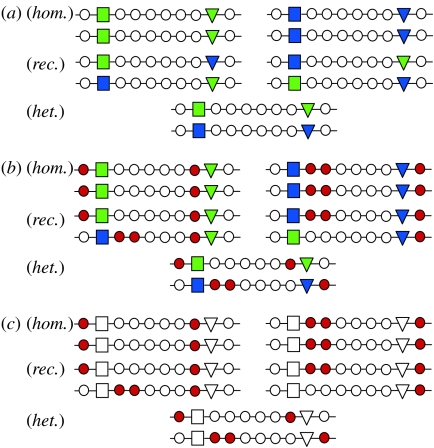Figure 1.
Schematic of ABC evolution. Positive epistatic selection maintains moderate linkage between combinations of functional immune genes (coloured squares and triangles) that work well together (Gregersen et al. 2006). At (a) t=t0: the homozygotes (hom.) show a low fitness (overdominant selection), the recombinants (rec.) a low fitness (epistatic selection) and the heterozygotes (het.) a high fitness (heterosis). At (b) t=t1: recessive deleterious mutations (red circles) accumulate in haploblocks because purifying selection is inefficient when recombination rates are low (Haddrill et al. 2007). These mutations fix in a process similar to Muller's ratchet (Muller 1932). Once fixed, these mutations increase the efficacy of balancing selection and further reinforce linkage through epistatic selection against recombinants. At t=t1, the homozygotes have a very low fitness (overdominant and purifying selection), the recombinants a very low fitness (epistatic and purifying selection) and heterozygotes a high fitness (heterosis and no purifying selection). At (c) t=t2: even in the absence of balancing selection on the actual immune genes (open squares and triangles), purifying selection operates against the recessive deleterious mutations when expressed in homozygous condition, thus maintaining the polymorphism in the population. Homozygotes and recombinants have a low fitness (purifying selection), and heterozygotes have a high fitness (no purifying selection).

